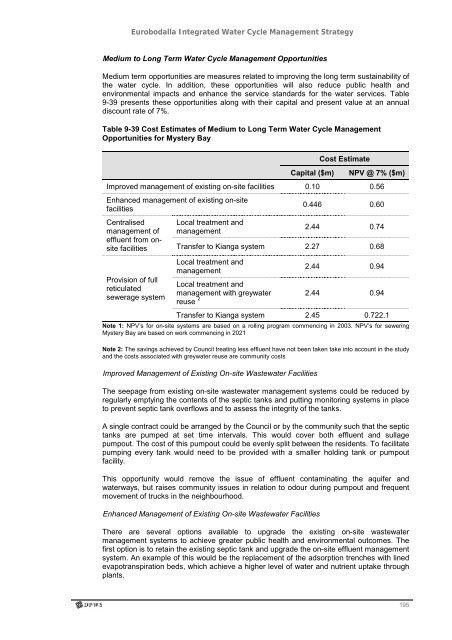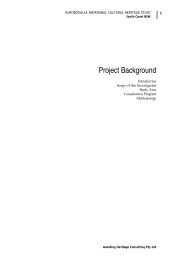Eurobodalla Integrated Water Cycle Management Strategy
Eurobodalla Integrated Water Cycle Management Strategy
Eurobodalla Integrated Water Cycle Management Strategy
Create successful ePaper yourself
Turn your PDF publications into a flip-book with our unique Google optimized e-Paper software.
<strong>Eurobodalla</strong> <strong>Integrated</strong> <strong>Water</strong> <strong>Cycle</strong> <strong>Management</strong> <strong>Strategy</strong><br />
Medium to Long Term <strong>Water</strong> <strong>Cycle</strong> <strong>Management</strong> Opportunities<br />
Medium term opportunities are measures related to improving the long term sustainability of<br />
the water cycle. In addition, these opportunities will also reduce public health and<br />
environmental impacts and enhance the service standards for the water services. Table<br />
9-39 presents these opportunities along with their capital and present value at an annual<br />
discount rate of 7%.<br />
Table 9-39 Cost Estimates of Medium to Long Term <strong>Water</strong> <strong>Cycle</strong> <strong>Management</strong><br />
Opportunities for Mystery Bay<br />
Cost Estimate<br />
Capital ($m) NPV @ 7% ($m)<br />
Improved management of existing on-site facilities 0.10 0.56<br />
Enhanced management of existing on-site<br />
facilities<br />
Centralised<br />
management of<br />
effluent from on-<br />
Local treatment and<br />
management<br />
0.446 0.60<br />
2.44 0.74<br />
site facilities Transfer to Kianga system 2.27 0.68<br />
Provision of full<br />
reticulated<br />
sewerage system<br />
Local treatment and<br />
management<br />
2.44 0.94<br />
Local treatment and<br />
management with greywater<br />
reuse 2<br />
2.44 0.94<br />
Transfer to Kianga system 2.45 0.722.1<br />
Note 1: NPV’s for on-site systems are based on a rolling program commencing in 2003. NPV’s for sewering<br />
Mystery Bay are based on work commencing in 2021<br />
Note 2: The savings achieved by Council treating less effluent have not been taken take into account in the study<br />
and the costs associated with greywater reuse are community costs<br />
Improved <strong>Management</strong> of Existing On-site Wastewater Facilities<br />
The seepage from existing on-site wastewater management systems could be reduced by<br />
regularly emptying the contents of the septic tanks and putting monitoring systems in place<br />
to prevent septic tank overflows and to assess the integrity of the tanks.<br />
A single contract could be arranged by the Council or by the community such that the septic<br />
tanks are pumped at set time intervals. This would cover both effluent and sullage<br />
pumpout. The cost of this pumpout could be evenly split between the residents. To facilitate<br />
pumping every tank would need to be provided with a smaller holding tank or pumpout<br />
facility.<br />
This opportunity would remove the issue of effluent contaminating the aquifer and<br />
waterways, but raises community issues in relation to odour during pumpout and frequent<br />
movement of trucks in the neighbourhood.<br />
Enhanced <strong>Management</strong> of Existing On-site Wastewater Facilities<br />
There are several options available to upgrade the existing on-site wastewater<br />
management systems to achieve greater public health and environmental outcomes. The<br />
first option is to retain the existing septic tank and upgrade the on-site effluent management<br />
system. An example of this would be the replacement of the adsorption trenches with lined<br />
evapotranspiration beds, which achieve a higher level of water and nutrient uptake through<br />
plants.<br />
195

















